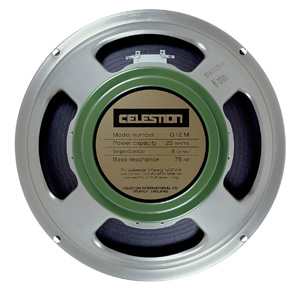Speaker Power
| Line 1: | Line 1: | ||
| + | [[Category:Gear]] | ||
{{portals_bar}} | {{portals_bar}} | ||
[[Image:G12MGreenback.jpg|thumb|300px|right|A 25 watt 12" Celestion Greenback]] | [[Image:G12MGreenback.jpg|thumb|300px|right|A 25 watt 12" Celestion Greenback]] | ||
Current revision
Guitarists Bands Lesson Plans Techniques Gear Theory Genres GMC Journal GMC Instructors Student Instructors All portals
Contents |
Power Background
The basis for the entire electric guitar revolution has been the use of electricity to provide the necessary energy to create, modify, and produce the sounds made by the player. Electricity is introduced to the amplifier and a small current is sent to the electric guitar to feed power to the pickups (passive). The pickups generate a magnetic field which is influenced by the vibration of the strings. The fluctuations in the field provide electrical current feedback which is then sent back to the amplifier for processing.
This signal is then modified and adjusted by the amplifier via a preamp phase and any number of post processes before being sent to the power amplifier (tube or solid state) of the amp. From here the final signal is sent as an electrical current to the speaker(s). The speakers are equipped with a magnet which reacts to the electrical current and cause the speaker cone to flex and move which creates vibrations in the air that are heard by the ear.
The electrical signal sent from the amplifier to the speaker(s) varies in power, current, and resistance. A working knowledge of these attributes are needed in order to properly pair speakers with amplifiers and to obtain a desired volume or effect.
Definitions
Impedance: Is the electrical resistance produced by a component or circuit (a speaker in this case). Unit of measure is Ohm.
Wattage: Is the power applied to an electrical system or component.
Power: Is the time rate at which energy is emitted.
Ohms: Unit of measure of Impedance.
Amperage: The strength of a current of electricity.
Cabinet: A housing (often wooden) which contains 2 or more speakers wired together.
Wattage
Wattage is the industry standard for measuring how much power an amplifier produces. This has become analogous with "loudness" or volume produced by the amplifier but is often misunderstood as such. For instance, a 40 watt tube amplifier will be significantly louder than a 40 watt Solid State amplifier, all other things constant.
When pairing a powered amplifier with a speaker cabinet it is wise to match the rated wattage output of the amplifier with the rated wattage of the speaker cabinet as closely as possible. Matching the Ohms of the amplifier and the cabinet is even more crucial since mismatching the ohm rating of the components can cause permanent damage.
Formulas
Ohm=Ohm
Power=Watts
Amperage=Amps
One Ohm = Power / (Amperage^2)
Related to Speaker Power
The rated wattage of speakers in a cabinet simply add up to produce the overall wattage of the cabinet. So four (4) 25 watt Celestion Greenbacks create a cabinet rated at 100 watts (4x25 = 100). Whether the speakers are wired in parallel or series does not matter for wattage.
Related to Volume
The perceived volume will increase only 3 Decibels every doubling of wattage based on the parabolic nature of diminishing returns regarding power to volume. So a 100 watt amplifier will only be 3 decibels louder than a 50 watt amplifier.
Examples
Example 1:
100 watt Amp Head with 8 Ohm speaker puts out how many Amps?
Answer:
8 Ohm = 100 watts / (I)^2
Solve for I. I = (100/8)^.5 = 3.5 Amps
Example 2:
100 watt Amp Head with 4 Ohm speaker puts out how many Amps?
Answer:
4 Ohm = 100 watts / (I)^2
Solve for I. I = (100/4)^.5 = 5 Amps
From the above examples we can see that a 4 Ohm jack puts out 5 Amps which is more than the 3.5 Amps from the 8 Ohm jack on a 100 watt Amp head. In fact at 100 watts 4 Ohms puts out 43% more electrical current than the 8 Ohms. This is why you should never plug a 16 Ohm speaker cabinet into an 8 or 4 Ohm jack on your Amp head. But plugging an 8 Ohm speaker cabinet into the 16 Ohm output of your Amp head may not always cause damage right away if at all.
Related GMC Lessons
No related lessons at this time.






